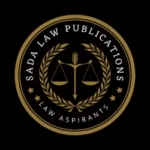Legal Challenges in Regulating Artificial Intelligence: Liability, Bias, and Global Frameworks
- 30 Apr 2025
- Yashasvi Panwar

Explore the key legal challenges in regulating artificial intelligence, including liability, bias, intellectual property, and global governance. Learn how legal systems are adapting to AI technologies.
Introduction: The Rise of Artificial Intelligence in Law and Society
Artificial Intelligence (AI) is transforming industries across the globe—from healthcare and finance to education and law enforcement. AI systems enhance efficiency, reduce human error, and open new frontiers of innovation. However, this rapid technological growth has created significant legal and regulatory challenges.
Current laws often fall short when it comes to addressing questions of AI liability, bias, and intellectual property. Furthermore, the absence of a unified global regulatory framework has added complexity to an already intricate legal landscape.
Who Is Liable When AI Causes Harm?
The Problem with Assigning Responsibility
One of the most pressing legal issues surrounding AI is liability. Traditional legal frameworks—like negligence and product liability—were designed with human actors and tangible goods in mind, not autonomous algorithms.
For example, if a self-driving car causes an accident or an AI medical tool gives incorrect advice, who is legally responsible—the developer, the user, or the manufacturer?
Recent Legal Developments
In the case of Zhang v. Chen (2024), a lawyer was held accountable for submitting AI-generated fake legal citations. This ruling reinforced the idea that users cannot blindly rely on AI tools. Legal systems must evolve to define clear accountability for developers and users as AI grows more autonomous.
Combating Bias and Discrimination in AI Systems
Biased Data Leads to Discriminatory Outcomes
AI learns from data—and biased data leads to biased outcomes. In sectors like hiring, lending, and law enforcement, this can result in AI reinforcing existing societal inequalities.
For instance, some AI-powered hiring platforms have favored male candidates over female ones, triggering legal concerns around discrimination.
Global Efforts to Ensure Fairness
Laws in California now require regular bias audits of AI hiring tools. Meanwhile, the European Union (EU)‘s AI Act (2024) prohibits “high-risk” AI systems in sensitive areas like education and law enforcement to prevent unjust outcomes.
Still, many AI algorithms remain “black boxes,” making it hard to trace or correct biased decisions.
Intellectual Property and AI-Generated Content
Who Owns AI-Generated Works?
AI can now create music, art, literature, and even software code. This raises key questions:
Can AI be considered an author?
Does training on copyrighted material violate creators’ rights?
Currently, most countries—including the United States—do not grant copyright to works created entirely by AI. Such content often enters the public domain, unless substantial human input is involved.
A Fragmented Legal Landscape
Differing National Approaches to AI Law
There is no universal approach to AI governance. Countries and regions adopt different policies, causing confusion for global businesses and developers.
In the U.S., AI regulation varies by state. Some states require transparency when AI is used in high-impact decisions, while others limit government use of AI.
By contrast, the EU’s AI Act provides a structured risk-based framework, demanding higher transparency and oversight for high-risk applications like healthcare and law enforcement.
The Need for Global Coordination
Different legal traditions and priorities—such as privacy in the EU vs. innovation in other nations—make global harmonization challenging. But coordinated international standards are essential to ensure ethical and safe AI development worldwide.
AI’s Role in the Legal System
AI in Legal Practice and Courtrooms
Legal professionals are increasingly using AI for tasks like document review, legal research, and decision support. While AI can boost productivity, it raises concerns about:
The accuracy of AI-generated evidence
Ethical issues in AI-assisted judicial decisions
Some courts use AI-based risk assessment tools to guide decisions on bail and sentencing. However, these tools can unintentionally reflect racial or socioeconomic biases, compromising fairness in the justice system.
Conclusion: Regulating AI for a Just Future
To regulate AI effectively, lawmakers must revise outdated laws and establish clear frameworks that define responsibility, ensure transparency, and prevent discrimination. International collaboration will be crucial for creating coherent AI policies across borders.
Educating legal professionals and the public about AI’s capabilities and limitations is also vital to building trust and avoiding misuse.
Recent court decisions and legislation suggest that the law is beginning to adapt. With continued cooperation between policymakers, developers, and legal experts, we can harness the power of AI while protecting society from its risks.
References
- https://www.redalyc.org/journal/6338/633875004009/html/
- https://www.mccarthy.ca/en/insights/blogs/techlex/landmark-decision-about-hallucinated-legal-authorities-bc-signals-caution-leaves-questions-about-requirement-disclose-use-ai-tools
- https://www.clio.com/resources/ai-for-lawyers/artificial-intelligence-and-the-law/
- https://www.elitelawyer.com/artificial-intelligence-law
- https://www.byteplus.com/en/topic/381871?title=ai-regulations-2025-case-studies-navigating-the-complex-landscape-of-technological-governance
- https://www.morganlewis.com/blogs/sourcingatmorganlewis/2023/03/addressing-legal-challenges-in-the-ai-ml-era
- https://www.americanbar.org/groups/business_law/resources/business-law-today/2024-april/big-data-big-problems/
LATEST BLOGS





